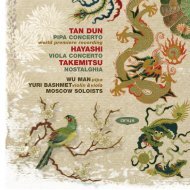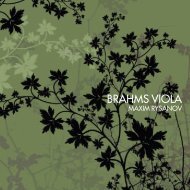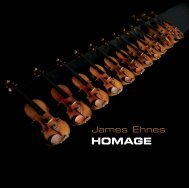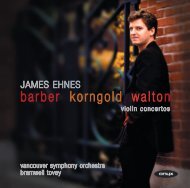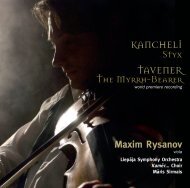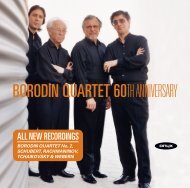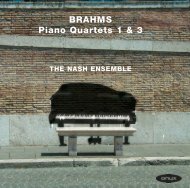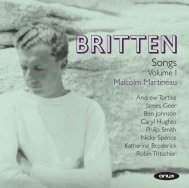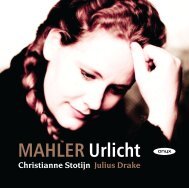You also want an ePaper? Increase the reach of your titles
YUMPU automatically turns print PDFs into web optimized ePapers that Google loves.
Bach and transcriptionFrom the end of the 16th century, musicians and theoreticiansperfected a system of codes for expression and compositionthat contributed tothe spread of a shared language. It was common practice toadapt musical scores to the players and instruments availableon any given occasion.Bach’s music lends itself particularly well tosuch adaptation: his works are so structurally and conceptuallyperfect that they transcend soundand timbre. Many can be played on any instrument withoutaltering their intrinsic value. Bach was famously wont to reusehis own music in different instrumental or indeed vocalcombinations.<strong>Viktoria</strong> and I agreed that it would be interesting to focus onthe practice of transcription, accompanying two originalconcertos, BWV 1041 and BWV 1042, with two newly transcribedcompositions. We opted for the Concerto BWV 1053, written forharpsichord in E major, but reused by Bach himselfin two cantatas, and probably originally intended for oboed’amore. I immediately thought of transcribing it in D major, notonly because the brighter key suits the violin, but also becauseits astounding central Siciliano features a glorious melody thatsuits the violin perfectly.<strong>Viktoria</strong> and I, having often performed the sonatas for violinand harpsichord, were keen to find a piece we could play withorchestra. One concerto is particularly well suited to this idea,BWV 1060. The original version is for two harpsichords andstrings, though Bach first drafted it for two violins, or for violinand oboe. I feel this unprecedented version works very well,enriching the composition with a range of new nuances.Key here is not only the reality of performance, but also theunderlying aesthetic concept: rigour of form and musicallanguage, together with inventive brilliance in performance, werefeatures of the 18th century. Once we understand exactly howand why these expressive forms came about and interacted,the entire period comes magically to life.© Ottavio Dantone, 2013Bach und die TranskriptionSeit Ende des 16. Jahrhunderts schufen Theoretiker undMusiker, um zu einer wahren und gemeinsamen Sprache zugelangen, ein System kompositorischer Regeln, das auf denAusdruck zielte. Es war bekanntlich üblich, Partituren der Anzahlund auch Art der zur Verfügung stehenden Instrumenteanzupassen.Bachs Werke eignen sich besonders gut, transkribiert zuwerden: Seine Musik weist über sich hinaus und setzt sich überjede Äußerlichkeit oder klangliche Festlegung hinweg, da sie inForm und Anlage vollkommen ist. Viele seiner Werke könnenunbesorgt auf einem beliebigen Instrument ausgeführt werden,ohne dass sich ihr innerer Wert veränderte. Bach pflegtebekanntlich einen großen Teil seiner Musik bei anderenGelegenheiten wieder zu verwenden, auch in seinen Kantaten.Wiktorija und mir kam der Gedanke, die Praxisder Transkription ins Licht zu rücken, indem wir zwei originaleKonzerte, BWV 1041 und 1042, mit zwei neuen Bearbeitungenvergleichen. Die Wahl fiel auf das Konzert BWV 1053, das in E-dur für Cembalo geschrieben war und von Bach noch einmal inzwei Kantaten verwendet wurde, ursprünglich aber wohl fürOboe d’amore bestimmt gewesen war. Ich hatte sofort die Idee,das Werk in die Tonart D-dur zu transkribieren, in der die Violinebrillanter hervortritt, aber der Hauptgrund für diese Wahl warder erstaunliche Mittelsatz (Siciliano), der mit seinerwunderschönen Melodielinie für die Eigenschaften der Violinewie geschaffen ist.Wiktorija und ich haben unzählige Male Bachs Sonaten fürVioline und Cembalo aufgeführt und wollten gerne ein Stückfinden, das wir gemeinsam mit Orchester aufführen können. Esgibt ein Konzert, das sich dafür hervorragend eignet, dasKonzert BWV 1060. Die Originalfassung ist für zwei Cembali undStreicher, war von Bach aber für zwei Violinen, oder Violine undOboe, skizziert worden. Diese Version, wie man sie noch nieversucht hat, bereichert meiner Meinung nach diesewunderschöne Komposition um neue Facetten.Es gilt nicht nur über die Aufführungspraxis nachzudenken,sondern auch über das ästhetische Konzept: Strenge von Form



